How to add refiners to your search results page in SharePoint Server
APPLIES TO:  2013
2013  2016
2016  2019
2019  Subscription Edition
Subscription Edition  SharePoint in Microsoft 365
SharePoint in Microsoft 365
The previous article in this series, Plan to use refiners on a search results page in SharePoint Server, showed how to identify and plan to use refiners on your site. In this article, you'll learn:
How to map a crawled property to a refinable managed property
How to configure the Refinement Web Part to use custom refiners
How to map a crawled property to a refinable managed property
In our Search Center scenario, we knew we wanted to use the following refinable managed properties:
| Refiner to use | Refinable managed property |
|---|---|
| Manager |
RefinableString01 |
| Internal Writer |
RefinableString02 |
| Editor |
RefinableString03 |
| Content Type |
RefinableString04 |
| Requested Publish Date |
RefinableDate01 |
The procedure for mapping a crawled property to a refinable managed property is the same for all refiners. The following example procedure explains how we mapped the crawled property that represents Internal Writer to the RefinableString01 refinable managed property.
On your Search Center, on the Site Settings page, select Search Schema.
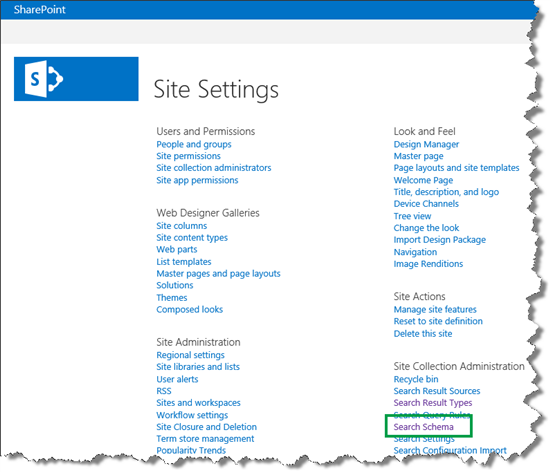
In the Managed property field, type the name of the refinable managed property to which you want to map a crawled property, and then click the arrow button.
In our scenario, we typed RefinableString01 .
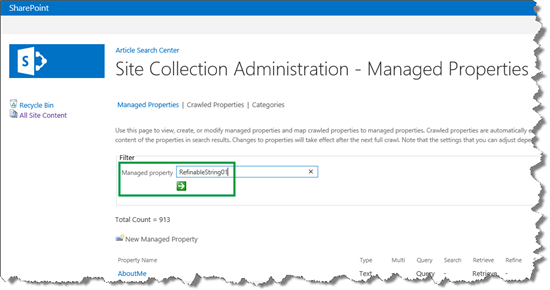
From the Property Name field, select Edit/Map Property.

On the Edit Managed Property page, click Add a Mapping.

In the Crawled property selection dialog, use the Search for crawled property name field to search for the crawled property that you want to map to this refinable managed property.
In our scenario, we knew we wanted to use the site column called Internal Writer . Crawled properties don't contain spaces. Therefore, we entered InternalWriter .
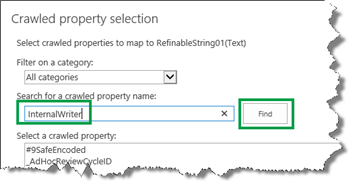
Two crawled properties were found: ows_q_USER_Internal_Writer and ows_Internal_Writer .
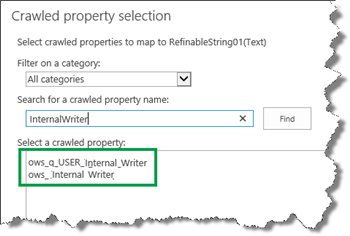
If you have questions here, your confusion is understandable. This part is somewhat tricky. There are actually two crawled properties, which might seem strange, considering that we have only one Internal Writer site column. So which crawled property should we choose to map to the refinable managed property?
Let's take a closer look at what's going on. The difference between the two crawled properties is the prefix. One has an ows_q_USER_ prefix, and the other has ows_ .
Important
When mapping a crawled property to a refinable managed property, select the crawled property with the ows_ prefix.
If you want more information about the naming convention for crawled and managed properties, see From site column to managed property - What's up with that?.
Select the crawled property with the ows_ prefix, and then click OK.
In our scenario, we selected ows_Internal_Writer .

On the Edit Managed Property page, notice that the crawled property is added to the Mappings to crawled property field.

In the Alias field, enter a name for the refiner.
In our scenario, we entered InternalWriter .

It's important to understand that the alias that you enter here is not the refiner name that will be shown on your search results page. This alias is meant to make your life a bit easier when you're configuring refiners in the Refinement Web Part (see procedure below). Remember, you can't change the name of the refinable managed property. Therefore, when you do the configuration, you'll have to deal with many refinable managed properties that have similar names, RefinableString01 , RefinableString02 and so on So, the alias is a good reminder of which value that you mapped to the property.
To finish the mapping, click OK.
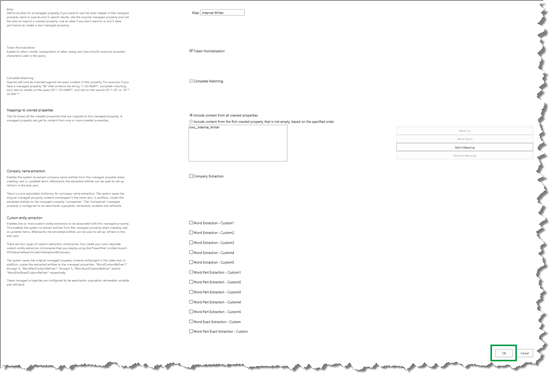
The following screen shots show the final result after repeating the steps from the procedure above for the remaining four refiners.


How to initiate a reindexing of a list or library
When you've mapped all the refinable managed properties that you want to use, you have to do a reindexing of your list or library. For information on how to do that, see How to create a Search Center Site Collection and enable crawling of your content in SharePoint Server.
How to configure the Refinement Web Part to use custom refiners
By default, the Refinement Web Part is included on the search results page. In the previous blog post I showed you how to configure the Search Results Web Part to use a new result source. The two refiners Author and Modified date were also displayed.
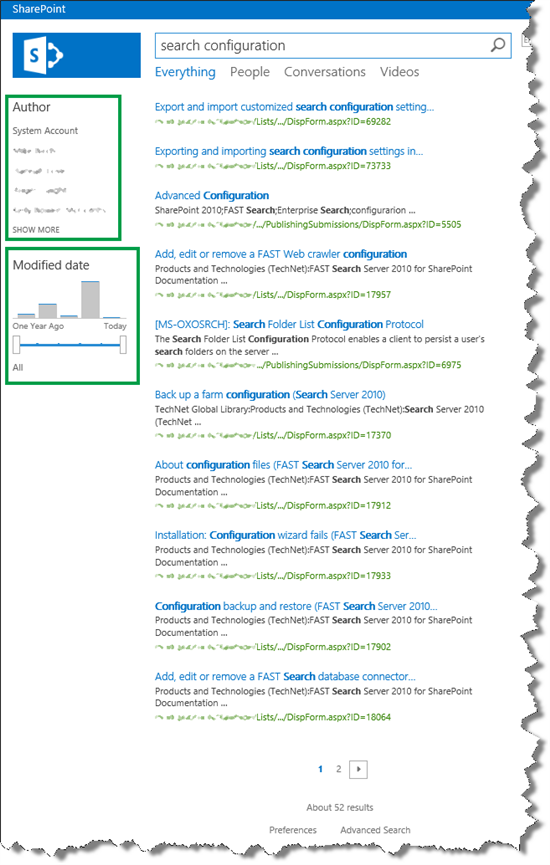
To display custom refiners, here's what you should do:
On the search results page, click the Settings menu, and then click Edit Page.
In the Refinement Web Part, click the Web Part Menu, and then click Edit Web Part.
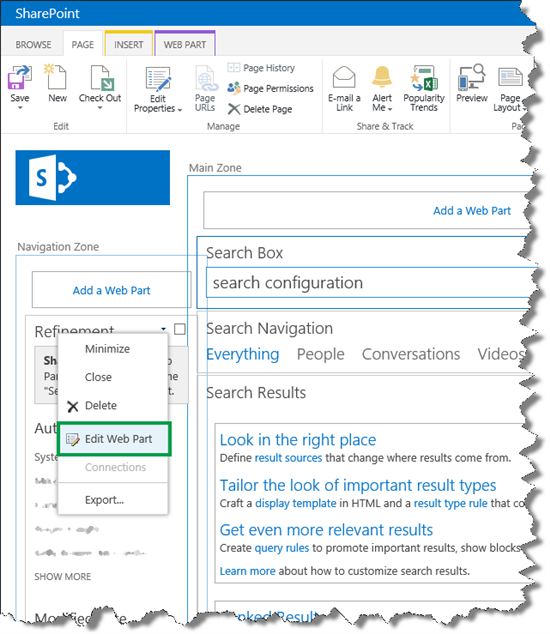
In the Web Part tool pane, click Choose Refiners.
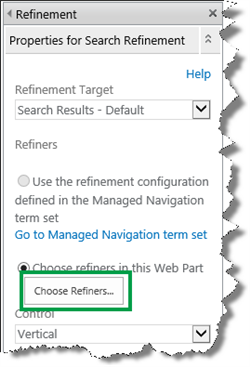
In the Selected refiners section, select the refiners that you don't want to display on your search results page, and then click Remove.
In our scenario, we removed all the default refiners.
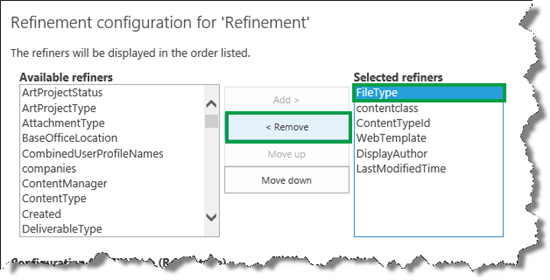
In the Available refiners section, scroll down and select a refinable managed property.
In our scenario, we selected RefinableString1. This is the refinable managed property that is mapped to the crawled property ows_Internal_Writer . Notice that sample values are shown (a good sign that we're on the right path), together with the alias InternalWriter .
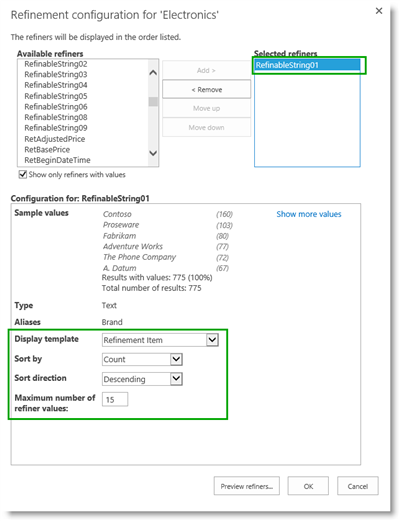
Click Add.
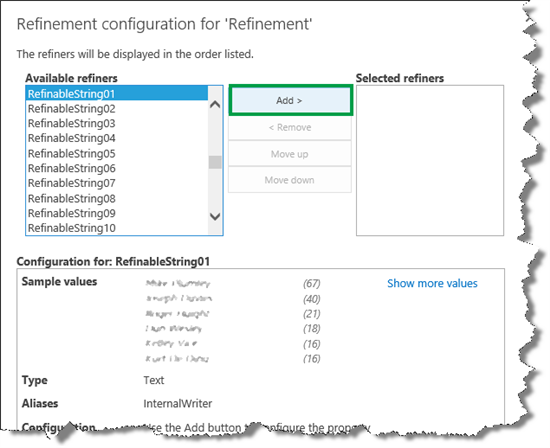
This moves the RefinableString01 property over to the Selected refiners section. When a refiner is moved over to the Selected refiners section, additional configuration options are shown. They will be explained in steps 10 and 11.
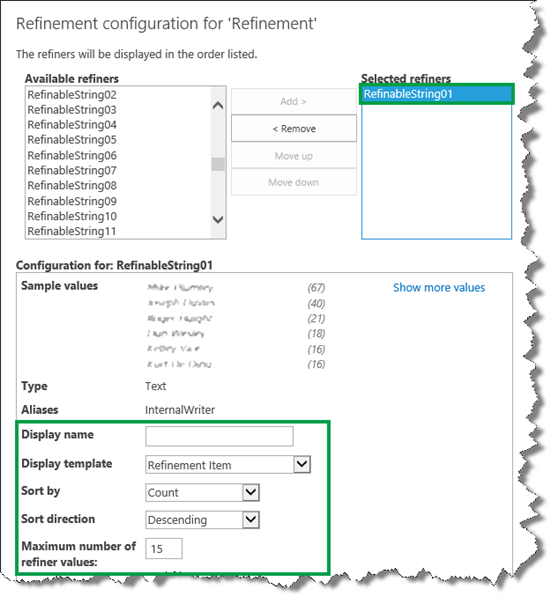
Repeat steps 5 and 6 to add all the refiners you want to use on your search results page.
In our scenario, we added the five refinable managed properties that we configured in the previous section.
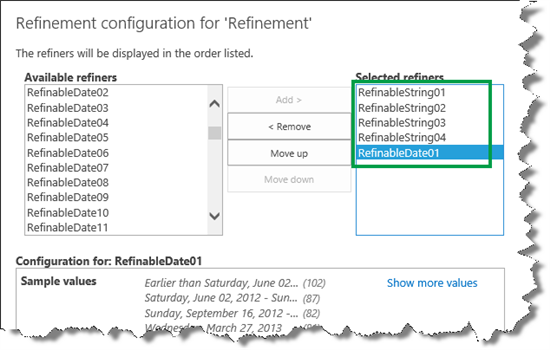
To preview the refiners, click Preview Refiners.
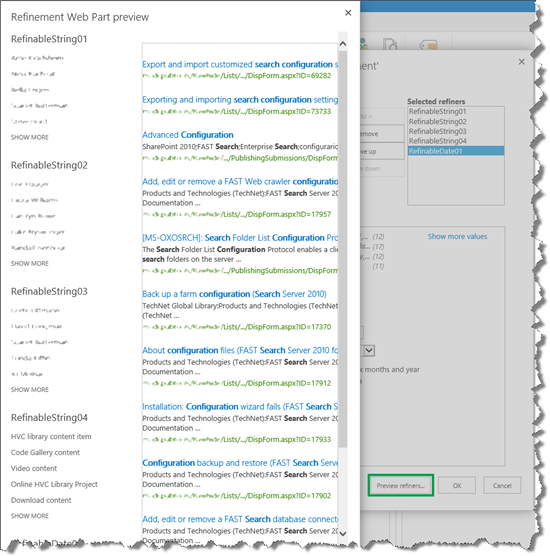
To change the display order of refiners, select the refiner you want to move, and then click the Move up or Move down button.
In our scenario, we selected RefinableString04 (notice the Alias name), and selected Move up until it was the first property in the Selected refiners section.
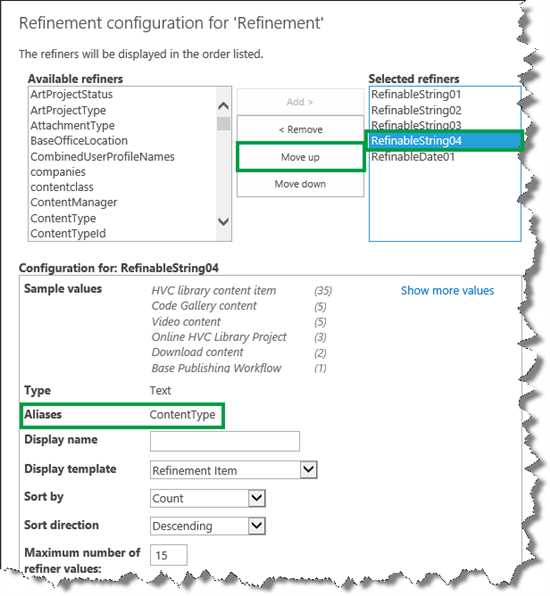
To enable users to select multiple refiner values, from the Display template menu, select Multi-value Refinement Item.
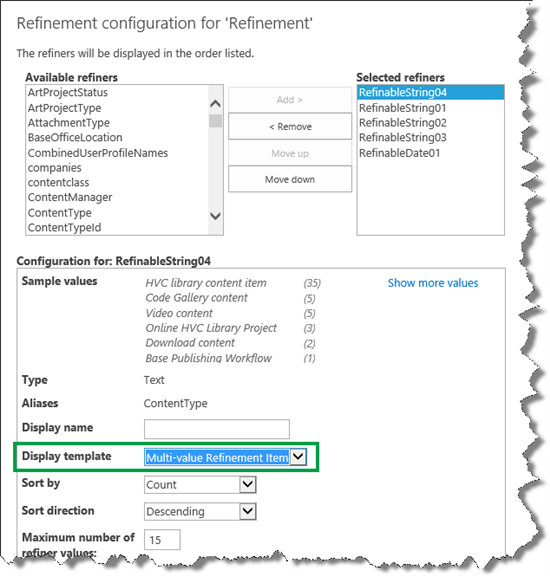
We clicked Preview refiners again, and verified that the ContentType refiner (RefinableString04) was displayed first, and that it had check boxes that would enable users to select multiple refiner values.

We repeated this step for the refiners RefinableString01 , RefinableString02 , and RefinableString03 .
The RefinableDate01 refiner represents Requested publish date . By default, the refiner values are shown in a list, which makes it difficult for users to see the date range.
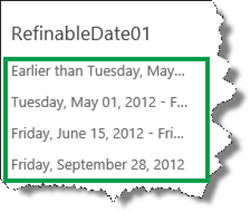
To display the refiner values in a more user-friendly way, in the Refinement configuration dialog, from the Display template menu, we selected Slider with bar graph. In the Dates section, we selected Last day, week, month, six months and year.
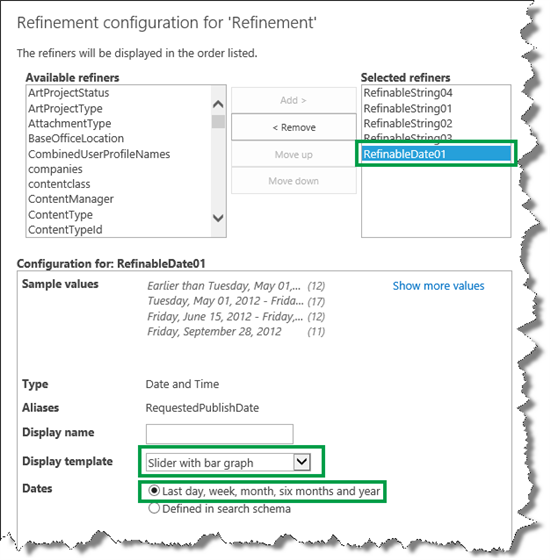
When we now previewed our refiners, the values for the Requested Publish Date refiner ( RefinableDate01 ) were perfectly displayed as a graph.
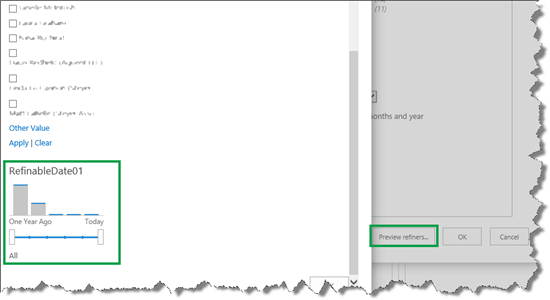
But, there was more thing that we needed to improve: the refiner display names. RefinableString01 , RefinableString02 , and so on do not make much sense to users.
To change the refiner display name, in the Display name field, enter the name that you want to be displayed for each refiner.
In our scenario, for the RefinableString04 refiner, we entered Content Type .
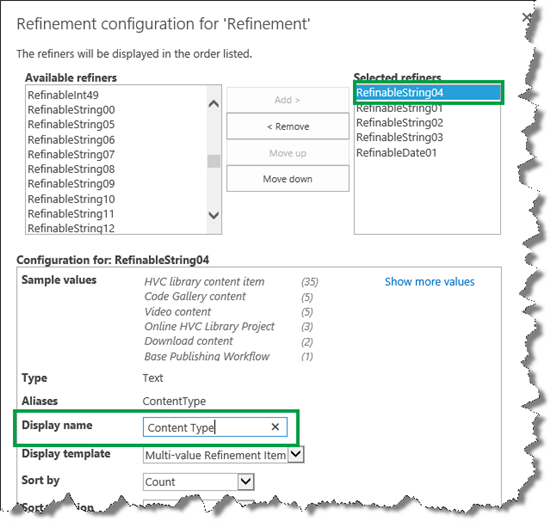
Repeat this step for all your refinable managed properties.
To save the configurations, click OK in the Refinement configuration dialog, and then OK in the Web Part tool pane.
Save the page.
In our scenario, the five refiners were now correctly displayed on the search results page.

But, there was one small detail that would make the refiners even better. Right now users couldn't see numeric details for the refiner values. For example, we could see names of writers that had written articles that had to do with search configuration . However, we couldn't see how many articles they had written.

To see this information, we needed to add counts to the refiner values.
How to add counts to refiner values
To add counts to refiner values, you'll have to edit a display template. When you work with display templates, you'll make life a lot easier for yourself if you map your network drive. By doing this, you'll be able to work with display templates from Windows Explorer. Stage 6: Upload and apply a new master page to a publishing site in SharePoint Server explains how to map your network drive.
In your mapped network drive, go to Display Templates --> Filters.
To add counts to refiners where it's only possible to select one refiner value at a time, open the HTML file Filter_Default. To add counts to refiners where it's possible to select multiple refiner values, open the HTML file Filter_MultiValue.
Change the value for ShowCounts to true.
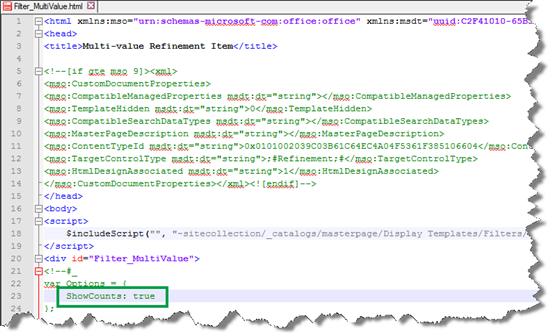
Save the file.
To verify that refiner counts are displayed, enter a query in your search center.
In our scenario, we again entered search configuration . We could now see that the writer "Bella Engen" was the writer of five articles on the subject that had something to do with search configuration. Nice!
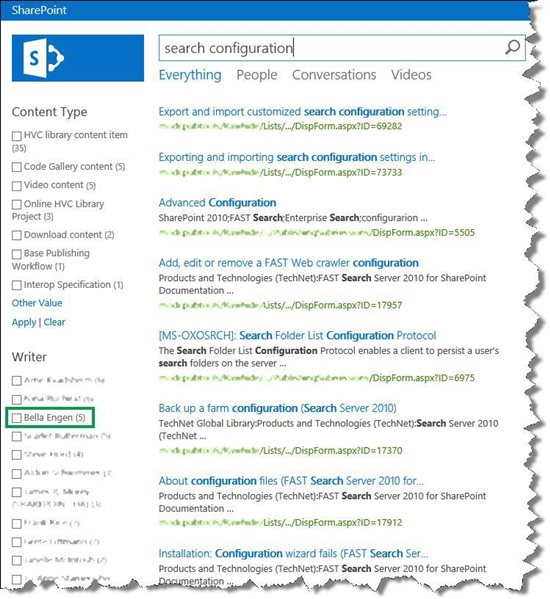
Next article in this series
How to add a custom search vertical to your search results page in SharePoint Server